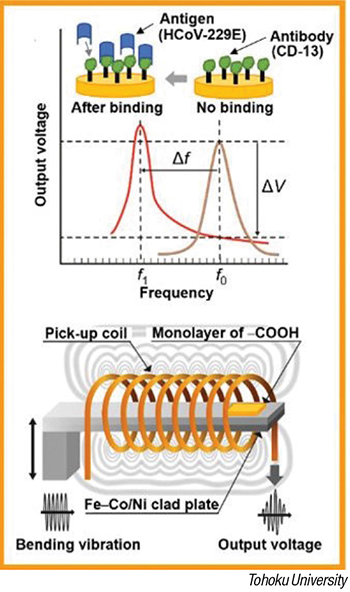Wireless device detects coronavirus — no batteries required – ChemEngOnline

January 1, 2023 | By Gerald Ondrey
A collaborative research group in Japan has engineered a self-sustaining device that can detect the presence of COVID-19 particles or droplets in air. The device, which requires no batteries, employs a magnetostrictive clad plate composed of iron, cobalt and nickel, generating power via alternative magnetization caused by vibration. The vibration resonance frequency of the Fe-Co/Ni plates, which are coated with the receptor protein coronaviruses use to enter our cells, changes when the virus is absorbed, providing an indication that COVID-19 particles are in the air.

“We know that resonance frequency changes when the weight of a magnetostrictive material changes, but we set out to answer whether this is also the case when a virus is absorbed and if this absorption is detectable,” says Fumio Narita, co-author of the study — published in Sensors and Actuators A: Physical — and professor at Tohoku University’s (Sendai, Miyagi, Japan; www.tohoku.ac.jp) Graduate School of Environmental Studies.
The researchers modified a 0.2-mm thick Fe-Co/Ni plate with a rectifier/storage circuit that harvests bending vibration energy and enables the wireless transmission of information. The plate transmits signals with the power obtained from bending vibration at 115 or 116 Hz. A change in clad plate weight affected the resonance frequency and altered the transmission intervals, meaning it could detect any substances that adhered to the clad plate. Next, the group created the bio-recognition layer, choosing to focus on human coronavirus 229E (HCoV-229E) — one of the seven types of coronavirus that affects humans. They immersed the clad plate in a CD13 protein solution and performed sensing experiments. When the coated clad plate was subjected to bending vibration, the resonance frequency decreased after HCoV-229 was absorbed, verifying whether the charged power could transmit virus detection as a signal.
The device could be used on other pathogens with modifications to the bio-recognition layer. “In the future, we hope to further develop our device and see if it applies to other viruses, such as MERS, SARS and COVID-19,” says Narita.



